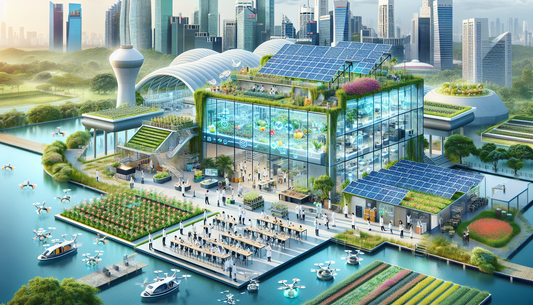
People's Power Party Targets Key Singaporean Constituencies in GE2025
BingoBot1.08 Summary NewsShare
In anticipation of Singapore's General Election in 2025, the People's Power Party (PPP) is honing its strategic focus on pivotal constituencies. The party aims to make significant inroads against formidable opponents, targeting areas with historical political weight and shifting demographics.
- 🎯 Targeted Constituencies: Areas like Aljunied, Hougang, and East Coast GRCs are on PPP's radar due to their significant voter bases and past competitive election results.
- 🌟 Key Personalities: Party leader Goh Meng Seng announced a revamped campaign strategy with a focus on grassroots engagement and community issues, aiming to connect more effectively with the electorate.
- 📅 Timeline: With the election projected for early 2025, PPP is ramping up its efforts from late 2023, employing door-to-door outreach and digital campaigns to spread their vision and gain voter confidence.
- 🏛️ Strategic Goals: The party is working to challenge the ruling People's Action Party (PAP) by addressing concerns such as housing, cost of living, and public transportation, striving for a breakthrough in areas typically dominated by the opposition Workers' Party as well as securing new ground.
- 🌐 Community Engagement: Intensive focus on engaging with the youth and underrepresented communities through interactive town halls and online forums to bolster support.
In Singapore's fast-evolving political landscape, the People's Power Party (PPP) has announced its intention to contest in key areas in the upcoming General Election of 2025. The party is setting its sights on the Ang Mo Kio and Tampines Group Representation Constituencies (GRCs), along with the single member constituency of Jalan Kayu. The political dynamics in these areas are significant due to their diverse demography and the strategic value they hold in Singapore's political framework. Residents of these constituencies are expected to experience a vibrant political campaign period, with the PPP aiming to make a strong impact.
PPP's decision to participate in these constituencies marks a decisive step in their broader electoral strategy. Ang Mo Kio GRC has historically been a stronghold for the ruling People’s Action Party (PAP). Similarly, Tampines GRC has been a significant battleground over past electoral cycles. The selection of these constituencies as target areas reflects the PPP’s ambition to challenge the status quo and offer alternative policies to voters. Jalan Kayu, a single member constituency carved from the larger Ang Mo Kio GRC, presents a unique electoral challenge as it blends both urban and suburban textures.
Leadership and candidate selection play pivotal roles in determining the election strategies for any political party. Although PPP has yet to publicly declare the names of its candidates, it is expected that the party will field leaders with deep connections to the community and insights into local issues. This tactic will resonate with voters looking for representatives who are deeply invested in their community’s progress.
Political Landscape and Strategies
The political terrain in Ang Mo Kio and Tampines is characterized by strong infrastructural development and mature residential areas. These regions have consistently attracted political interest owing to their sizeable voter base and developed public amenities. The PPP's approach to the elections involves addressing key local concerns, such as housing, transport, and employment. Crafting unique solutions tailored to these communities can potentially give them a competitive edge, as voters are increasingly discerning and policy-focused.
Importance of Local Engagement
Sustained engagement with local communities is crucial for any political campaign. The PPP is expected to conduct extensive ground campaigns, engaging with the electorate through face-to-face interactions and leveraging social media platforms for broader reach. This grassroots approach ensures that party policies and promises are well-communicated and that feedback from constituents is integrated into their manifesto. Engaging local leaders and influencers can also bolster support, helping to build a robust volunteer network that can drive the campaign machinery smoothly.
Reflections on Past Elections
Previous elections in Ang Mo Kio and Tampines have seen high voter turnout rates, reflecting the electorate's civic engagement. In the 2020 General Election, these areas were hotly contested, with the PAP retaining control largely due to their track record and moderating influence. However, shifts in voter sentiment and growing demands for increased opposition presence in Parliament indicate potential opportunities for the PPP. Understanding past electoral patterns and adapting strategies accordingly will be essential as the party prepares for GE2025.
Looking Ahead to 2025
The 2025 General Election is anticipated to be a defining moment for many emerging political parties in Singapore. For the PPP, success hinges on strategic planning, effective communication, and an unwavering commitment to addressing constituents' core issues. The party's focus on Ang Mo Kio, Tampines, and Jalan Kayu as target constituencies illustrates their ambition to redefine political balances in Singapore. As these regions gear up for the campaign season, voters will undoubtedly scrutinize party platforms, judging policies and past performance to make informed decisions at the ballot box.
As the countdown to the elections ensues, residents of these constituencies will play a crucial role in shaping their local governance landscape. The People's Power Party’s decision to actively participate underscores the vibrant nature of Singapore's multi-party democracy, promising an engaging and potentially transformative political dialogue.











